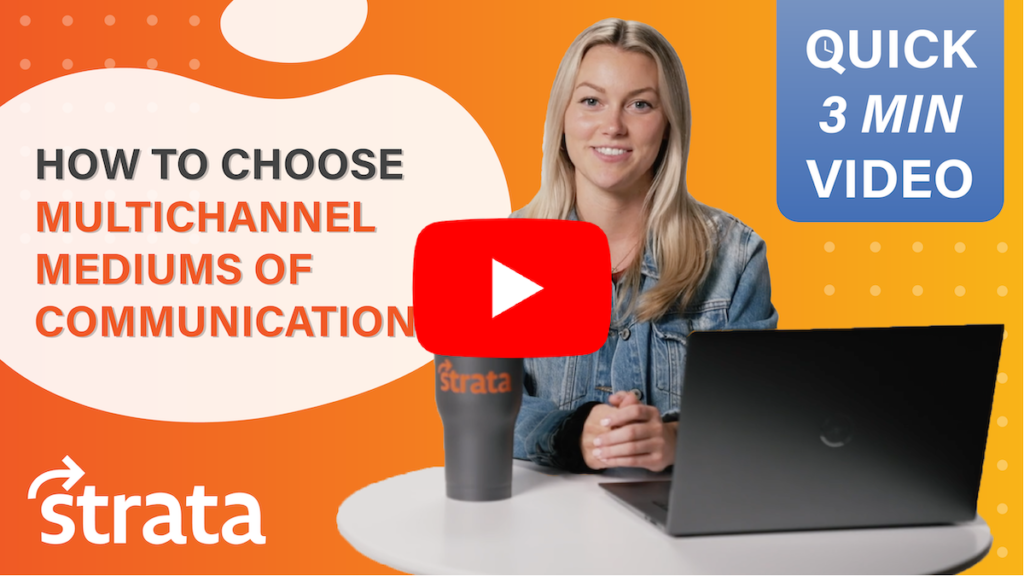Key Takeaways from SHSMD Connections 2022
Back at it Again!
It was great to see everyone at SHSMD 2022 in National Harbor, MD! With our new, brightly lit and eye-catching booth backdrop, we were able to meet new contacts – as well as catch up with current clients! The light and inviting atmosphere of our booth made it a great space to discuss marketing goals and showcase some of what we do here at Strata.
With SHSMD 2022 wrapped up, we’re excited to see how our connections grow, and how we can continue to help healthcare marketers and others with offerings beyond just new mover marketing. Whether it’s patient acquisition, talent acquisition, or promoting your service lines – we’re here to take your marketing to the next level. With that said, here are a few of our key takeaways in case you missed the show or didn’t get to stop by our booth this year.

The Conference in Review
At the beginning of the show, the team first joined other SHSMD attendees at Monday morning’s keynote — delivered by Suneel Gupta, a bestselling author, host of an American Express docuseries and podcast, and Visiting Scholar at Harvard Medical School. He spoke on the importance of long-term successes coming from short-term embarrassment, and explained that by gathering people who will challenge, encourage, work alongside and coach you, you’re becoming “backable.” He also emphasized that putting yourself out there only helps you get better at what you do – and that it’s important to be “backed” by the team you’ve assembled.
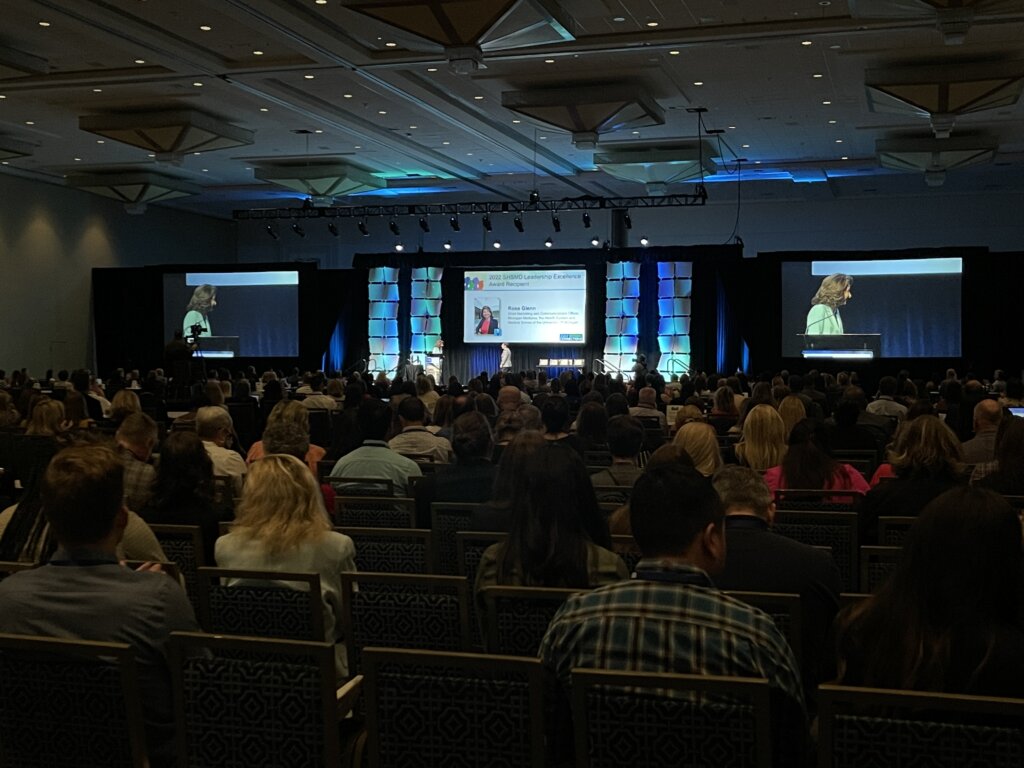
From there, the team moved to breakout rooms to learn a bit more about the needs and challenges that healthcare marketers currently face. We attended sessions surrounding digital and AI learning, nursing acquisition and retention, media buying innovations, and more.
A big topic was the idea that – as we’re continuing to traverse the digital age, it’s important that healthcare providers meet their potential patients and talent where they are. Whether someone is looking for an urgent care center, a primary care provider, or employment, the goal is to remain end-user focused. When marketing healthcare services to people in your area, it’s vital (no pun intended) to utilize demographic and psychographic data for the targeted population that your healthcare center serves. Because of this idea and the rise of ethical marketing, we’re seeing just how tactful marketing campaigns – both print and digital – need to be in order to be successful and worthwhile. Strata is well versed in this notion, and the atmosphere and chatter at SHSMD 2022 simply reiterated and expanded upon what we know to be true. Whether you need marketing that will facilitate patient acquisition, talent acquisition, or service line promotion, we’re here to make smart happen. We can help streamline your marketing to reach the talent you need and the customers you want. Right where they are.
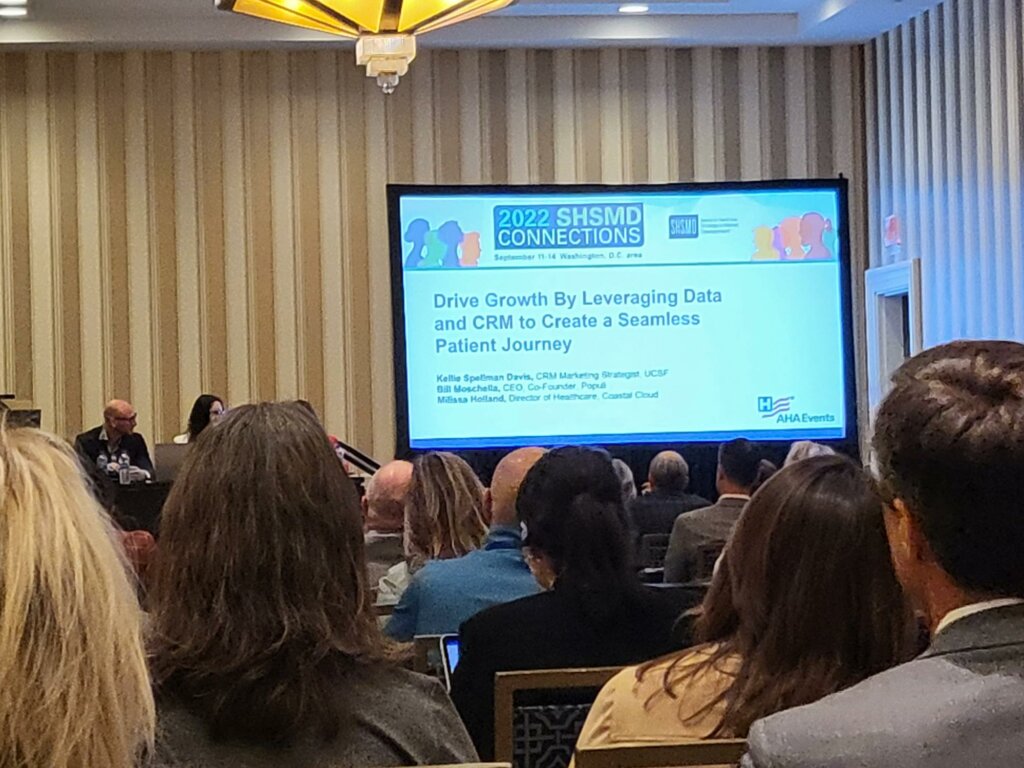
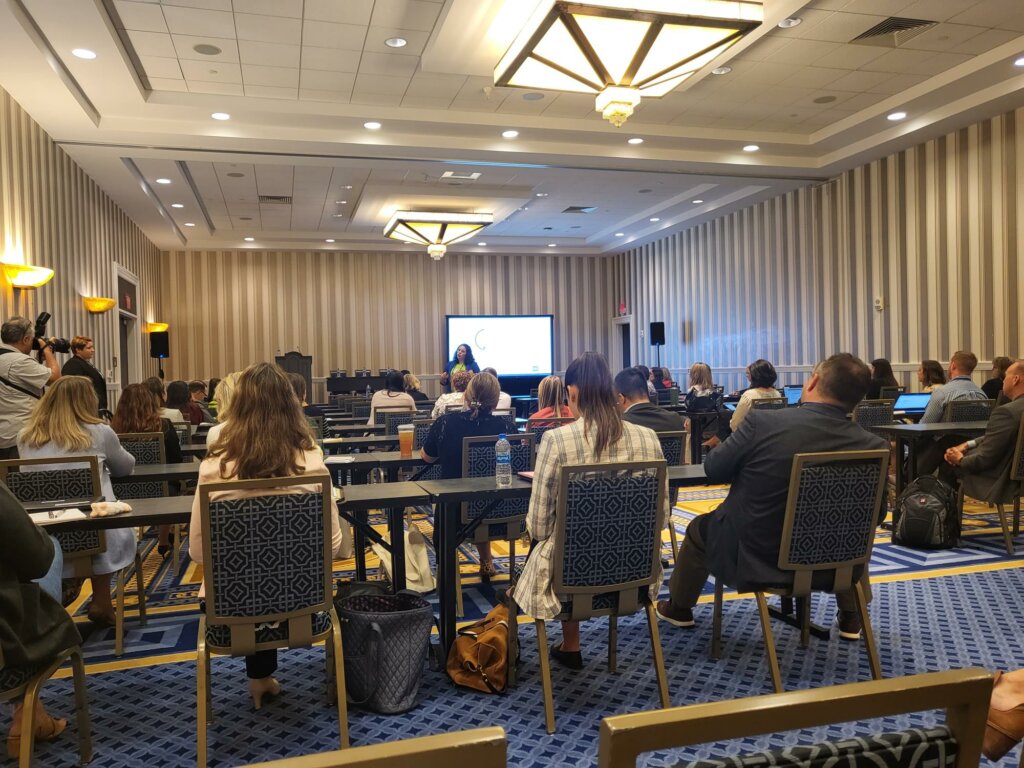
Some Final Thoughts
Last but not least – the conference reinforced the importance of good design to reach and engage your target audience! We’re glad that, here at Strata, personalized, eye-catching campaigns are right up our alley – and we have the experience and design talent to make them happen. Using demographic and psychographic data, as well as eye-catching imagery and layout, we create compelling pieces of print, direct and digital mail that follow branding specific to our clients and incorporate unique touches that help your system stand out among competitors.

Didn’t get to discuss your healthcare needs with us at SHSMD 2022? No worries. We’re happy to have a quick chat or set up a call. Contact us today!
Untrue & Debunked
With years of experience, we’d say we’re experts in direct mail marketing. But we’re not just the mail people. We provide highly impactful direct mail marketing that cuts through today’s digital noise to deliver a tactile experience and leave a lasting impression. That’s why we’re well versed in all of the misconceptions about direct mail floating around out there, and can tell you exactly why they’re untrue. Follow along as we debunk the 6 misconceptions of direct mail.
Misconception 1: Direct mail is past its heyday
Once in a while, we hear people speculate and assume that direct mail is past its peak – but just because direct mail has stood the test of time, doesn’t make it outdated. It’s been around for a while for a reason, and has evolved and changed over time – with the times. In fact, in a recent IAB survey, six out of ten marketers prefer direct mail over other offline channels and still include it in their direct marketing strategy today.
These days, direct mail breaks through the digital noise and is unique and different than other marketing tactics. It brings about nostalgia, as people enjoy the feeling of paper in their hands, similar to enjoying paperback books over kindles. Plus, for every 36 emails you receive (on average), you get 1 piece of mail in your mailbox. The possibilities are quite endless, with many exciting design opportunities and options. Really, direct mail is only boring and old if you make it that way.
Misconception 2: Compared to other tactics, direct mail doesn’t provide ROI
This one couldn’t be further from the truth. Don’t believe us? Here are just a few stats to back us up. The average lifespan of an email is 17 seconds, compared to direct mail’s average lifespan of 17 days. Up to 90% of direct mail gets opened, compared to only 20-30% of emails. Per USPS, 98% of people check their mail daily and Americans spend upwards of 30 minutes with their mail on a single occasion. Direct mail open rates can reach up to 42%. Recipients of direct mail also “purchase 28% more items and spend 28% more money than people who don’t get that same piece of direct mail.” Direct mail gets response rates 10 to 30 times higher than digital channels, according to the DMA (Direct Marketing Association).
Basically, direct mail usually does very well in terms of ROI, and it can (and should) be tracked – so make sure you’re getting the most out of it by making it trackable with the use of digital touchpoints.
Misconception 3: Direct mail marketing is expensive
When people think of print, they sometimes think of high-cost, but that’s not always the case. If you have a quality list and are getting the most out of each mailer you send, direct mail won’t seem all that expensive. What do we mean by a quality list? If you’re sending to strategic, particular contacts – not just any contacts, your ROI will be worth the price.
Additionally, print often gives you more for your money while other marketing practices alone may not (for example PPC, social media ads, email marketing platforms, and more). According to the stats, mail marketing is much more likely to be seen and paid attention to.
Misconception 4: Millennials and younger don’t like or pay attention to direct mail
Direct mail isn’t just effective for older audiences. Actually, 73% of American consumers (in general) say they prefer being contacted by brands via direct mail because they can read or review the information at their leisure. And, 41% of Americans of all ages look forward to checking their mail each day.
Millennials, specifically, like to feel important and seen, so the personalization opportunities of direct mail make for great millennial marketing. To add to this, many millennials and Gen-Z-ers have digital fatigue and find taking a “break” with print to be often enjoyable, and it “should be no surprise that those raised on the internet are best able to tune out online ads.” They also have shown to have a lot more trust in print resources than in digital.
Misconception 5: Direct mail works on its own and doesn’t integrate with other channels
These days, direct mail is actually an excellent touchpoint among many, especially when conducting a multichannel marketing campaign. And, we’d even say that combining tactics, even if it’s just two, is usually the way to go. In a recent study, a whapping 68% of marketing respondents saw that combining digital and direct mail increased visits to their websites.
So, how do you integrate physical with digital? By using a URL of a landing page or website, a PURL (personalized URL), BRC (business reply card), or a QR code. Any of these can be used to lead the viewer to a digital touchpoint. These can all also be used to measure attribution and better understand your target audience, and the emails and other information acquired from BRCs or online landing page forms can be used for email marketing, targeting customers with digital advertising, and sending further communication.
Misconception 6: Direct Mail = Junk Mail
Unlike junk mail, direct mail is focused, targeted, relevant, ROI-producing, and uses a quality send list. For more on why direct mail isn’t the same as junk mail, check out our blog, “Direct Mail vs. Junk Mail”, here. Strata can be a resource for direct mail with a surgically targeted list of prospects that are not only more likely to have a need for your project or service, but are also more likely to respond.
Now that it’s a bit clearer that direct mail is relevant, effective, and can be a huge part of the bigger picture of a marketing strategy, you may be interested in giving direct mail marketing or multichannel marketing a try. If so, give us a call.
That Will Interest Your Audience
In a few of our recent blogs, Buzzword Alert: Every Door Direct Mail (EDDM) and The Pros and Cons of EDDM, we gave you insight into what EDDM is, as well as its pros, cons, and alternatives. In this blog, we’re going over the top 5 best EDDM campaign ideas – in the case that you do choose to go the EDDM route as a part of your marketing strategy.
An EDDM Refresh
USPS’ Every Door Direct Mail service is a blanketed mailing approach sent to all of the potential customers near your business (depending on the routes you choose). Utilizing the provided mapping tool, that provides demographic data information based on census reports, you can choose the routes you’d like your mail piece delivered. Additionally, you can schedule this delivery for whenever it makes sense for your business. The mail you send can be self-designed, or you can work with a company like Strata to design it effectively and professionally. Learn more about what EDDM is at this blog, or explore its pros and cons, here.
Now that we’ve given you a refresh on what EDDM is – let’s dive into some effective campaigns to get you the most ROI.
Campaign Idea 1: Generosity
One of the best ways to entice customers is to provide a generous discount or offer. Or, simply giving them a small something that’s free – whether it’s small and attached to your mailer or provided through a sign-up or scheduled meeting – goes a long way.
Nothing gets customers in the door more than coupons, price deductions, and rewards. Give them something to entice them to at least come in and give your business a chance – even if that’s just to get a discount or redeem an offer. It’s quite likely that once they’re in (as long as you provide good products and/or services), they’ll return.
Introducing free giveaways can pique customer interest, making them feel like you care and are willing to give them something for their attention and possible business. Plus, if the giveaway is received via an exchange, once they “sign up” or schedule a meeting, you’ll then have their information for future communication.
Campaign Idea 2: Urgency
Whether we like it or not, humans like to know what’s going on. You know the phrase – curiosity killed the cat. We get “FOMO” – the fear of missing out – more often than we’d like to admit. That’s why using a term like “save-the-date” is so effective. The potential customer will likely read the rest of the card, because they’ll want to know what’s going on in their area. When you create urgency, people feel that they need to be in-the-know and on-the-go. Obviously, you’ll need some sort of “event” to accompany this type of mailer, but it could be something as small and simple as a limited time discount week, days or day, or a grand opening or reopening.
Campaign Idea 3: Playfulness
Entertaining and playful campaigns do really well when it comes to EDDM. This could mean including a scratch off game, or poll to make the mailer interactive and exciting. Interactivity can get the customer’s attention, and maybe even cause them to feel somewhat invested in getting the answers, winning the prizes, or otherwise finding an end result.
Another way to energize your mailer? Maybe it includes some sort of pop-up upon unfolding. Or, try invisible ink, dye cuts, and other unique folds. Any of these options can help you stand out from the pack and bring out energetic playfulness in your potential customers.
Campaign Idea 4: Proximity
A great way to get customers through your doors is to emphasize how easy it is for them to do so. Focus your mailer around the idea of proximity and the ease of locating and entering your business. Be sure to include an easy-to-read map of your location(s), and add in words such as “close by”, “just an order away”, or, “just a few blocks away” if that’s possible and applicable. With this type of campaign, you can also include a limited time offer to compliment the proximity with urgency. For example, “Stop in for $10 off your order of $50, we’re right down the road”.
Campaign Idea 5: Simplicity
We’ve all heard the acronym KISS. A great campaign tactic is to keep it very simple. Most viewers don’t have the time to digest a whole mailer and all of its contents, so limited text and bold blocks of imagery and/or color can go a long way. Simply providing your store name, address, website, and some great photos and blocks of color can create mystery that speaks just as much as content. Maybe limit it to just one good coupon. This kind of mailer can create recognition and brand awareness without overloading the customer with information.
Like we’ve said before, EDDM is not for every company and its marketing strategy – but if you do choose EDDM for your next campaign, make sure you do it strategically and effectively by using one or two of the campaign ideas above. In general, don’t forget that every mailer should at the very least include contact information, a compelling call-to-action, and memorable branding.
Looking for some more in-depth help to get started? Give us a call or shoot us an email.
Is it the Right Option for You?
In a recent blog, we went over what Every Door Direct Mail (EDDM) is, some of its positives and negatives, as well as some alternatives. Today, we’re diving a bit deeper into EDDM’s pros and cons so that, when you’re ready to launch your next direct mail campaign, you’re able to choose wisely.
What is EDDM Again?
Every Door Direct Mail, (better known as “EDDM”) is a blanketed mailing approach sent through USPS to potential customers near your business (aka – all of your “neighbors” nearby). You can use USPS’ provided mapping tool to select a geographic area, while viewing some demographic data based on census reports such as age-range, household size, and income. With this data in mind, you can choose what mail routes you’d like your piece delivered to – and, you guessed it, your mail gets delivered to every door. You can schedule this delivery whenever you’d like, within the parameters of the postal office.
With EDDM, you have the option of either creating the mailer design yourself, or working with a company (like Strata) to create a design that’s effective and professional. And – when using EDDM, you have two options, EDDM Retail and EDDM BMEU.
What’s EDDM Retail?
EDDM Retail is a good option for small businesses, restaurants, realtors, and local political campaigns. With this choice, you can create an account, send 200-5,000 pieces per day, per zip code, and simply drop your mailings off to the post office. You don’t need a permit with this option, and you can easily pay online or at the post office. The cost is currently $0.20 per piece.
What’s EDDM BMEU?
EDDM BMEU, on the other hand, is a good option for larger volume mailings, as there’s no volume limit and you may send to several different zip codes. As you can imagine, it’s slightly more involved than retail. You’ll need to make a Business Customer Gateway account, acquire a bulk mailing permit, and drop off your mailers to a BMEU – a large USPS mail processing center. The current cost for EDDM BMEU can be “as low as $0.168 per piece.”
The Pros of EDDM
Now that you know your EDDM options, we’ll go over the pros and cons. First – the pros. If your marketing budget is low and you’re looking for something that won’t put much of a dent in it, EDDM mailing can be a worthwhile choice. You can avoid high postage rates, generally, and postage discounts are available for most. Additionally, if your mailing is small and you’re not too concerned about a wide geographic area, you can again save on postage by opting for EDDM.
EDDM can work well for general awareness campaigns – such as showcasing a small business’ grand opening, letting people know you’re running for office, hosting a special event at a restaurant, introducing yourself as a realtor…the list goes on. If you want the general public to know about you, EDDM can help you do just that. Just make sure your business and/or brand is apparent by using quality branding and imagery, your logo(s), memorable colors and fonts, and other elements that people will take note of and will recognize if they see them again. If you’re not sure how to do this or what to include, give us a call.
The Cons of EDDM
Although EDDM is a good service that works for a lot of use-cases, it has its downfalls. With EDDM, you’re unable to really target a specified audience based on significant data, such as interests and hobbies, life changes, environment, age, income, and so on. Yes – you can find an area where many of the people meet some of these criteria, but with Every Door Direct Mail – it’s sent to exactly what it sounds like – every door. You don’t have the option to add people in or take people out if they’re in the selected demographic area and on the chosen mail routes. Therefore, you’re likely wasting paper, production, and money on people who have zero interest in your product, service, or event. You could be reaching out to people who fail to check their mail regularly, see your mailer and throw it out immediately, read it over and have no need or interest, or worse, are offended by your offering or service. What do we mean? Here are a few examples of what we liked to call “fail mail”:
- A BBQ restaurant flyer sent to a house of vegans
- A retirement home postcard sent to a couple in their twenties
- A daycare service mailer sent to someone single with no children
- A car dealership flyer sent to an eco-friendly bicyclist
Whether the “potential customer” doesn’t see it, throws it out, doesn’t want it, or is offended by it, the mailer was a waste of time, printing, and money.
On the other hand – maybe your mailer will actually interest most of your audience and you’re sending it to a large target area. Awesome! But – if your EDDM campaign is too large, you risk offsetting postage cost savings with extra production processing. Plus, paper costs right now are higher than normal due to the shortage, which could mean that printing and mailing to every door could cost you more than the response is worth.
Finally, EDDM does not provide the option to truly personalize your mailers. And, if you’ve read any of our other blogs, you know that personalization is a large part of direct mail success. In fact, a personalized CTA has been found to increase conversions by 78.5%. Without including a name, interest, favorite product, specialized offer, or personalized URL and QR code, your response rate is likely to suffer. If the mailer isn’t linked to anything else and doesn’t lead them anywhere personally specific, it’s not nearly as enticing or effective.
Next time you’re looking to send a mailer out to potential customers, fans, voters, guests, and so on, you may want to use EDDM (depending on your budget and needs), but as experts in the industry, we can say that there is often a more targeted strategy, like new mover marketing or multichannel marketing, that may work better. If you’re ready to get started on your next direct mail campaign, we’re here to help. Simply get in touch.
How to Fight it & Flourish
As spooky season approaches and Halloween is around the corner, we’re thinking a lot about our biggest fears. But today we’re not talking about ghosts or goblins or even Michael Myers. We’re talking about one of the scariest things of all to any workplace…complacency.
“Complacency is man’s biggest weakness. It creeps up on us when we least expect it.” – Jay Mullings
Even if you think your company isn’t anywhere near complacency, there’s still always room to evaluate and grow. And, you may be surprised by what’s lurking behind the door of contentment. Complacency is not only bad for your company, but good for your competition, which we’d assume will give you a bit of a fright. If employees aren’t challenged to improve, things are the way they are because it’s the “way they’ve always been”, and the company isn’t growing, it’s definitely affecting your revenue. But don’t worry – it’s never too late to change. In this blog, we’ll take a look at the best ways to avoid company complacency and ensure you’re periodically updating and enhancing your culture, practices, and marketing.
Complacency’s Cause
Complacency can sneak up on any company without warning, shielding it from growth and stifling creativity and innovation. Why? Because if companies are seemingly doing “fine” and meeting their goals on paper, they feel no “need” or urgency to change. That’s where the biggest mistake is made, because companies should always be looking to evolve and thinking about their vision for the future. If not, ideas become stale, talent becomes bored, and eventually, the company comes to a jarring halt without any clue of how they got there.
When everything seems to be going well, it can be difficult to disrupt successes. And it may feel like the right decision to let processes and practices take their course rather than think about next steps and development, but often “the riskiest thing we can do is just maintain the status quo.” Without urgency and consistency for change, employee performance shifts and can even decline. Statistics show that only 30% of employees in America are actually engaged in their work, and only 13% of employees worldwide are engaged in their office environment. With such low numbers already, it’s so important to keep employees excited, energized, and motivated for what they’re doing and what’s to come.
Combatting Complacency
With complacency being a bigger, scarier possibility than you may have assumed, it’s important to keep it top of mind and to make sure you’re doing your best to combat it. Start with communication of your company’s mission, vision, and values. Make sure they’re clear, known, and maybe most importantly – accurate and true. Know who you are. If you do – your employees will too, and in turn they’ll feel more connected with and motivated by your workplace. Allow employees to see their contributions to the bigger mission, and their worth as an asset to the overarching vision.
After all, having a good (and growing) company culture is key to combatting complacency and ensuring workplace satisfaction. How do you improve your culture? Many ways, but the most effective tools are company newsletters, employee highlights, group meetings, and employee appreciation. Again – make your employees feel valued, and they’ll more likely provide value.
Additionally, make sure team members feel important and part of the greater whole. Encourage managers and team members to communicate within their individual teams, and make sure responsibilities are delegated and well distributed. Employees are more likely to become bored when they’re doing the same tasks over and over, so give them room to be creative and explore new opportunities. You never know who may have the next best idea.
Lastly, be prepared for whatever may come your company’s way, and never be too afraid to challenge the status quo. If we’ve learned anything these past two years, it’s that anything can happen, and that the saying “it won’t happen to us” is just not realistic. It’s important to listen to the ideas of your employees and always be prepared for what’s to come with an open communication structure. Make sure you have multiple decision makers, not just one, and that employees feel comfortable enough to make some decisions without “permission” from a leader. Training your employees to make decisions on their own will be a key factor in combatting complacency.
Refreshing Without Fear
Almost as important as your workplace and its people is your brand and marketing. Without change and evolution, your marketing can quickly become out-of-date right under your nose (causing your employees to lack company pride and your audience to lose interest). But how do you know when it’s the right time to update your brand and marketing?
A sure sign (these days) of lack luster marketing is an absence of social platforms. Some would even say if you’re not online, you might as well not exist. And although we think that sounds a little spooky, we’ll admit that it holds some truth. If you’re hard to find and not posting relevant content and imagery, target customers may be choosing your competitors (who are more accessible and approachable) over you.
Also important to your brand and its relevance is your website. In this day and age, it’s very easy to tell when a website has been left alone so long that it’s developing cob-webs. If you’re finding that your website traffic is down and your customers aren’t interacting with it, it’s time for an upgrade. But, before any big changes, compile data and make purposeful decisions. What is your audience looking for? What do they respond well too? How can you quickly and easily get them to have interest in your company and purchase goods?
Additionally, make sure you keep your advertising and customer communication – whether digital or physical – energized and creative. Combine direct and digital marketing to reach specific audiences and keep your brand top of mind. Don’t settle for just one medium that “seems to be working” if multiple channels of communication could bring you more success.
Lastly, avoid complacency by focusing on helping the customer rather than selling to them. While the overall goal of most companies is to generate sales, it’s essential you show your customers that you care about their pain points and needs. To see all of these tactics in action, check out our recent blog on how to create successful marketing campaigns.
Company complacency can sneak up on you like a ghost in the night and lead to missed opportunities, poor customer service, and disengaged employees. Stay aware of the possibility of contentment and make sure you’re always exploring, evolving, and rising above the rest. Change is inevitable, but complacency doesn’t have to be.
For more information on what we do at Strata and how we can help you fight complacency with one of our marketing solutions, contact us today.
A Strata YouTube Channel Original
Choosing the right multichannel campaign mediums can be difficult if you don’t have a good starting foundation and the right tools. That’s why, in our most recent YouTube video, we walk you through the key things to keep in mind when making this decision, and how to pick channels that best fit your company’s marketing needs.
Evaluate Your Brand & Customers, First
Before you even look at where your audience is and what they want, look at your own brand, brand voice, offerings, and then your target audience. Once you have these nailed down, then you can think about your customers – because if you understand your customers, you can understand where it’s best to communicate with them. Get to know your customers on a deeper level through data and tracking so you can develop personas and demographics, and fully recognize their pain points, wants, and needs. Test and measure tactics, update and reaudit your customer experience, ask for customer feedback – whatever you need to do to truly know your audience and therefore get the most out of your multichannel campaign. After all, 86% of customers are willing to pay up to 25% more for products and services just to have a better customer experience. Once you know your audience, then, and only then, can you figure out exactly where to meet them on their multichannel journey.
If you want to know what comes next in choosing the right mediums of communication for your multichannel marketing campaign, click on the video below and hear more from our Marketing and Social Media Coordinator Bridget. Or, if you’d like to discuss this concept with one of our multichannel experts, contact us today to get your next (or maybe even your first) multichannel campaign started.
Not Our First Rodeo
Even though this wasn’t our first rodeo, SHSMD Connections 2021 didn’t disappoint. We had great conversations with so many show-goers, and we got to do one of our favorite things – talk new mover marketing.
In previous years, SHSMD Connections has brought quite the large crowd. Yet, with the needed precautions due to COVID-19, this year’s show created a much smaller, more intimate setting. Although we weren’t sure how the event would pan out, the smaller turnout gave Strata the chance to really chat with others in the industry, and learn more about the needs and wants of healthcare marketers.
About the Show & Our Experience
This year, two of our employees attended the conference in San Antonio, Texas from September 19-21. With Strata’s booth being front and center as guests entered the exhibit hall, our exposure was unmatched, giving us many great moments for conversation. Our bright orange and yellow (recently refreshed) colors kept the atmosphere light and fun, making it easy for the team to meet as many new contacts as possible while also connecting with familiar faces.

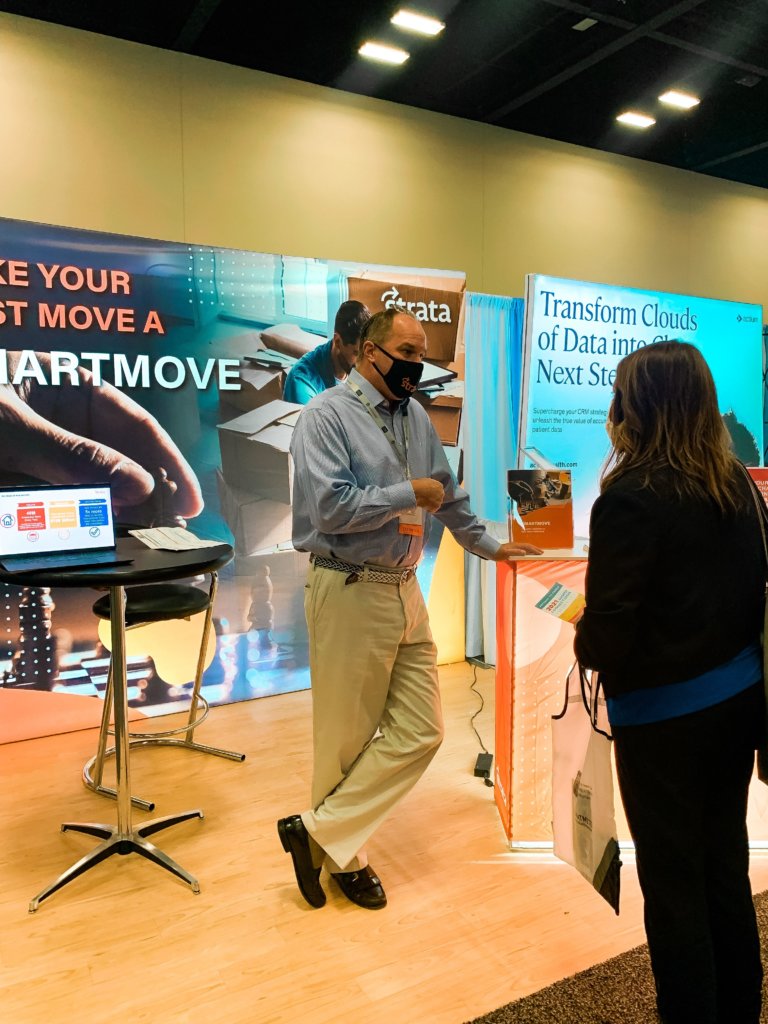
We’re really looking forward to seeing, post-show, how these connections flourish and how we can help healthcare marketers and others within the industry with their new mover marketing endeavors.
Our Takeaways
Our presentation of SmartMove and all that we offer was a huge success, and the feedback we were given emphasized the significant need for our services. Healthcare facilities aren’t just looking for direct marketing, but direct marketing that will make an impact and target the right people at the right time. Whether attendees were familiar with new mover marketing or not, our team educated them on Strata’s personalized touch and efficient processes.
But, not only did Strata come prepared to share our services – but prepared and excited to learn! On their breaks, the Strata team attended numerous breakout sessions and learned about everything from inclusion and diversity in the workplace, to problem solving, engagement, and leadership strategies. They even had the chance to hear from Burl Stamp, President and Founder of Stamp & Chase, who discussed how to properly and effectively engage with and lead teams, customers, and communities (especially post pandemic).
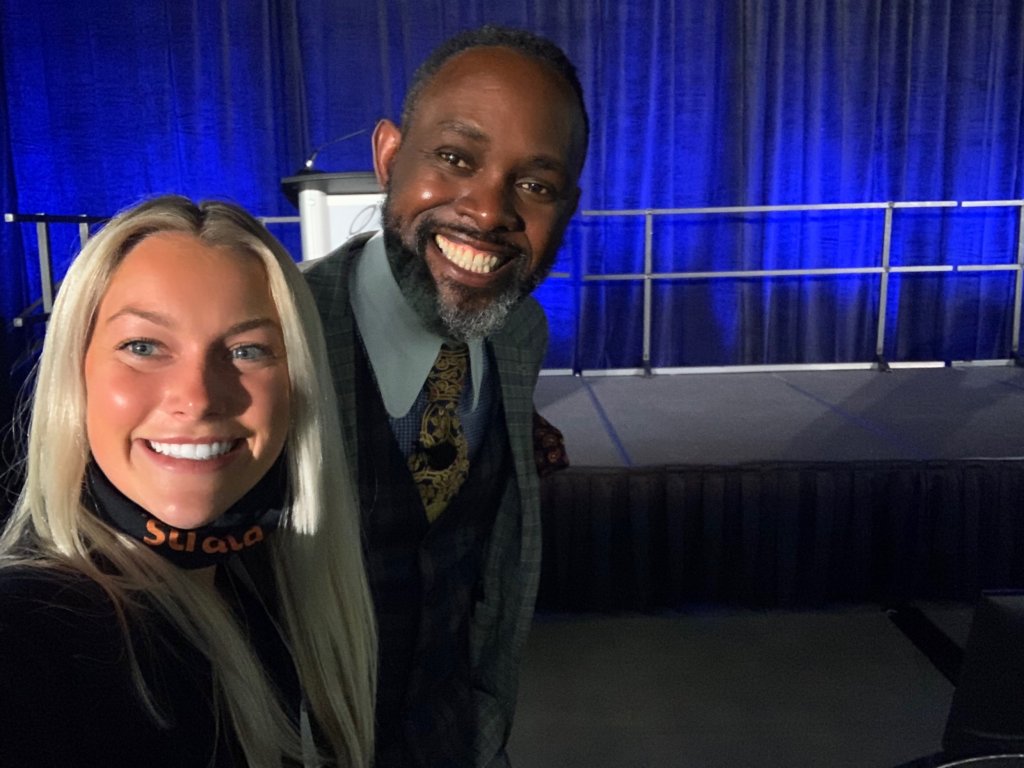
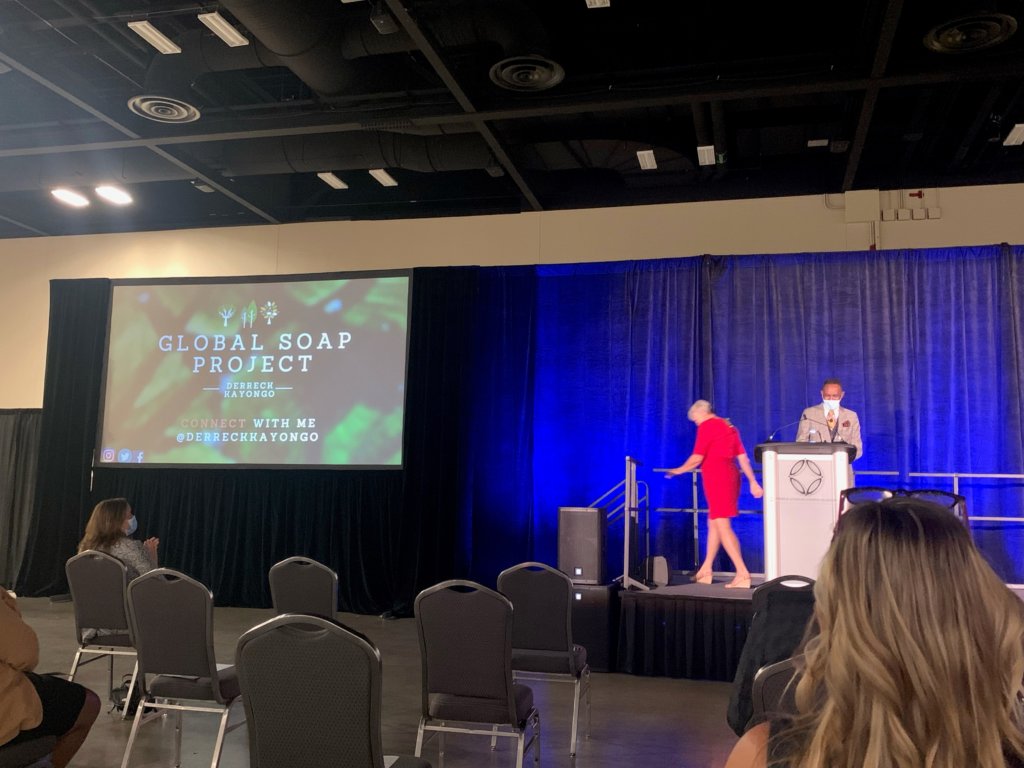
Another great session that the team partook in was Derreck Kayongo’s keynote. Derreck presented on the topic of company culture and how to tackle the subject of company diversity head on, by sharing stories of his own childhood to his own organization, the Global Soap Project. Derreck did a phenomenal job guiding the audience through diversity and inclusion problems, and how they impact the corporate bottom line. He left the crowd speechless. The team was incredibly grateful to have attended and listened in on such impactful conversations, and are so excited to not only come back with some new connections, but with takeaways to strengthen Strata’s services and culture.
Our Final Thoughts
Overall, SHSMD 2021 was a success for Strata. While it may not have looked like conferences of years past, we’re glad our team had great conversations and made solid connections with those that could attend. Not to mention, our promo items were a hit! See you next year, SHSMD!
Didn’t get to swing by and meet us at the show? Contact us today to see how we can help!
San Antonio, Here We Come!
At Strata, one of our favorite things to do is talk marketing. We’re problem solvers, and we pride ourselves on helping industries overcome their marketing challenges. With healthcare marketing being one of our many specialties, we’re excited to announce that the Strata team is heading back to the annual SHSMD Connections Conference in San Antonio, Texas from September 19th-21st, and we couldn’t be more excited!
SHSMD? What’s That?
For those who’ve never heard of SHSMD (aka the Society for Health Care Strategy & Marketing Development), it’s an AHA professional membership group that focuses on how the industry can evolve and change with new strategies, marketing, and technology, serving more than 4,000 members.
This year, SHSMD is celebrating the 25th anniversary of their annual “Connections” conference, and we can’t wait to connect with some of the industry’s best marketing and communications strategists. It’s been two years since we’ve been able to interact with these professionals in person, and we’re excited to be able to once again inform, challenge and validate their thinking, while also learning from the conference’s guest speakers from all over the country.
What We’re Looking Forward to & What We’re Bringing
This isn’t our first rodeo (even though it’s our first time going to Texas), as we’ve attended this conference for 20+ years. However, this will be our first time back with a refreshed look, thanks to our 2020 brand refresh. As marketing experts with almost 30 years of experience, we’re excited to bring our expertise to the show, and create some new, long-lasting relationships.
It’s clear that the healthcare landscape is evolving faster than ever, and to stay competitive, hospital systems need to start looking at marketing as a strategy rather than an afterthought. We plan to go into the show with an open mindset and to educate healthcare industries on the importance of New Mover Marketing and how SmartMove can help them achieve their patient acquisition goals.
If you don’t know who (or what) we do, Strata offers a wide range of client-driven solutions to help companies solve complex marketing and communications challenges. We’re a lot of things (innovators, go-getters, marketing experts), but we’re people first—and we know you are, too. That’s why we believe the best way to help a business achieve its marketing goals is by focusing on the people who work there.
Learn More
If you’re attending this year, stop by booth 216 to learn more about how Strata can help you with your marketing efforts. We can’t wait to meet you!
If you’re not attending the upcoming conference- no worries. Contact us today to discuss your own personal marketing plan from the comfort of your own home.
Straight from Our Creative Designer
If you’ve read any of Strata’s blogs, you know that we believe in the power and effectiveness of good marketing. We believe not only in planning, strategy, organization, touchpoints, messaging, and call to actions, but in the great design. Without great design, you could be missing out on a ton of potential customers through failure to grab their attention. Because design has such a wide range of options (nearly endless), we’ve compiled a shortlist of design trends you should keep in mind when planning and executing your next marketing campaign.
Revitalized Layout & Structure
Minimalism
Minimalism is a buzzword that simply never goes out of style. Minimalist design is clean, simple, and sleek, and because of its bare nature, makes the viewer pay attention to the most important details on the page or in the email, letting them know exactly what you want them to do (for instance, a call-to-action) or what you want them to understand. When designing minimally, don’t be afraid to use white space, interesting hierarchy, and unique spacing. Mix it up and surprise your audience with something different and less busy than the rest of your work.
Digitally, audiences are now looking for “simple, sleek, easy-to-use interfaces. If you’re unsure how to simplify your website for a more minimalist design, use tools like eye-tracking tests to see where your viewers are focusing. Once you have eye-tracking data, you can simplify your website to include just those areas that are important to and effective on viewers. It’s also important to eliminate unnecessary pop-ups that can distract from relevant content. “Ensure the user journey is purposeful by opting for simple and time-saving design features so they can easily search for items of interest.”
Storytelling
In marketing, we’re almost always telling a story. It’s important to make sure that the story is not only conveyed by words – but by imagery and layout too. “…more than ever, consumers are looking to buy from brands they can relate to, that feel approachable, relevant and authentic. To achieve a genuine connection, designers and marketers should use storytelling.” Make your story even stronger and increasingly significant to customers with personalization and tailored content, product value, and authenticity. One of the best ways to tell your story is through video, which is why we’ve just launched our new YouTube channel. Take a look to see how we tell our story(s) through imagery and video.
S-Curve Layout
The “s-curve” layout is a unique way of leading the viewers eye down or across a webpage, email, or even a printed document. It’s formed by using imagery on the left, words on the right, and then words on the right, and imagery on the left (or another similar variation) to bring the viewer’s focus from left to right, back and forth. This helps potential and current customers better understand the marketing they’re looking through, but also keeps their attention as they do so.
Spruce Up Your Imagery
Hand-Drawn Graphics
This type of design can help your company stand out among the rest of the modern, boxy design that’s more popularly used. In today’s digital world, “it is so rare to get a handwritten note from someone that when we do, it feels extra personal.” Adding a small sketch or unique handwritten note to your design, without overdoing it, can increase its authenticity, personalization, and the overall personality of your marketing materials.
Illustrated Iconography
Iconography has been hugely popular for a long time, mostly due to its easy-to-digest nature. It’s a simplistic way to get certain company ideas and information across, such as product offerings, features, and company values. Yet, these days, “icons have been granted much more visual prominence. Conveying brand personality, unique artworks and most importantly, clearly communicating the intended message”. We’re now using them for much more than just features, and making them a lot more interesting to look at than just a simplistic phone symbol. Illustrated and unique icons can be used to help your company stand apart from the crowd, and distinctively illustrate your brand. “Aside from speeding up loading times with lightweight graphics, icons—especially zhuzhed up icons—soften brand identities and encourage an emotional connection to be made with the audience.”
Surrealism
Since the beginning of 2020, reality has often seemed very surreal, making all of us question what we really know to be true and trustworthy. “Considering how mixed up –– and messed up –– day-to-day life often seems; it’s no wonder graphic design is exploring imagery that bends the edges of reality.” Using strange, juxtaposing, and even somewhat jarring elements can catch a viewer’s attention yet also feel oddly familiar if they’re more adapted to strange happenings and visuals. Play around with imagery that tells the story in a more imaginative way, and see how your audience responds. It just might strike a chord!
Data Visualization
Artwork is beautiful – but data is important. Your customer may like how your brand and imagery looks, but they’ll likely love imagery that conveys facts and figures they can trust and understand. Data can be overwhelming when it’s simply delivered using a ton of words and numbers, so using imagery to make the information more readable, understandable, and visually appealing is often the way to go. And, if done right, “prospects can be encouraged to become customers through data.”
Refresh Your Branding Design
Pops of Color
Even if your brand is more neutral and duller, you can always spice things up with a few pops of color at the right place and time. A good splash of color can help bring a message to life without losing brand identity – if done correctly. Here’s a good example from Airbnb. Their brand colors are primarily a bright magenta/red and white, but here, they use a ton of colors to energize a host award without taking away from their overall brand image.
Bold Typography
No matter who your audience – young, middle-aged, or older, bright and bold type is exciting and eye-catching. It draws the reader in, if used in the right place(s), and catches anyone’s attention for at least a few seconds, even from far away. Plus, large type provides maximum readability, as long as the font isn’t too out-there.
Incorporate Cultural Happenings
Socially Conscious Design & Authentic Representation
Social consciousness. Diversity. Representation. Understanding. All of these – in today’s world and into the future, are extremely important and at the top of many customer’s minds. In our current society, “design and culture are integrally connected.” Showing a better future through imagery and design can often be the best way to facilitate change. This year and in 2020 especially, “social unrest and movements for anti-racism have captured national attention,” so you were remiss as a company if you didn’t at least acknowledge or even take a stance on these issues. Socially conscious design with authentic representation of several ethnicities, cultures, sexualities, and more has become a huge part of graphic design practices. “Within the theme of socially conscious design, key trends include authentic representation, sustainability, and celebrating diversity and imperfection.”
Sustainability & Natural Elements
Environmental concern. Sustainability. Eco friendly practices. These, too are at the forefront of today’s initiatives, especially after a tough year where many of us have been consistently indoors. We were truly forced to take a better look at our outside world, and our impact on it. Many companies, including Strata (through Operation Eco) are focused on preserving the earth and sustaining the health of our planet. Through natural imagery and sustainable design your company can further convey your care and efforts, and give your audience a sense of peace and tranquility. “As consumers think about waste and their environmental footprint more than ever before…expect to see more and more packaging designs that emphasize sustainability through natural iconography, neutral color palettes, and eco-conscious materials.”
Optimism & Support
Lastly, although we’ve had a rough last year or so, we can finally see brighter days ahead, and so can our customers! Show your support and emphasize this brightness with optimistic design and “good news” layouts. Make your audience feel a sense of trust for your company by showing that you care for them and empathize with their current struggles.
Looking to implement some of these unique design practices into your marketing campaigns, but still not sure where to start? Contact Strata.


